

Page


Page
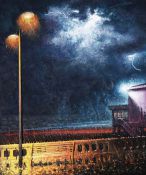
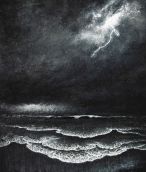
© Luc Dartois - June 2019
updated in November 2020

_ _
_ _
_ _
_ _
_ _
_ _
~
~
~
~
~
~
~

Rythmic of the waves of "I salute you old Ocean!" is closed to the “Nocturnal Sea”.
But proportions are inverted: two third for the sky, one third for the Ocean and the ground.
The lightning is playing the role of a finger. Its direction is guiding the eye to the distant light, then a spring effect is throwing back the eye on the light on the foam.
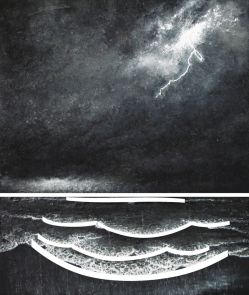
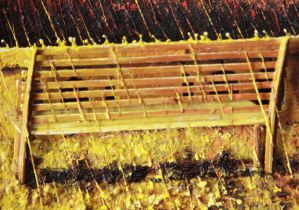
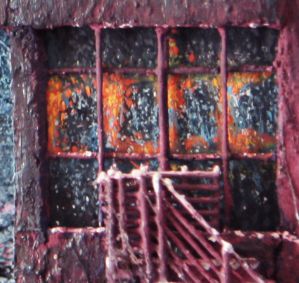

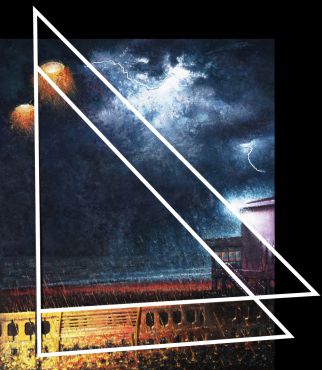
This painting has been turned into a timeless subject. It can be a reference to the past, a more or less blurred childhood memory, as well as a moment about the present.
Or it can rather show a vision of the future representing a world without humans, natural elements continuing theyr cycles without paying attention to individual histories or History.
It's probably “The Casino” which gives the key of the two other paintings: on one side the "Nocturnal Sea" in colour with an ambiguous atmosphere which seems to contain an underlying threat, on the other side "I salute you old Ocean!" in black and white like a veil thrown over a last look...
A life and death cycle including childhood memories, and destinies coming from coincidences, improbabilities... like a casino game.
God does not play dice... but Man is playing roulette.
The warm light of the street lamp can evoke distant memories as a fleeting glimpse out of the corner of the eye, or the fascination that a child can feel for thunderstorm.
The bench is empty, the child is grown, the dream is gone.
Thus, it is possible to cover the song "Confortably numb" from the Pink Floyd band, whose lyrics are echoing the image.
External light of the building is pale but very intense. It is located on the outside edge of the triangle. It can be seen as a symbol of a false hope.
Internal light of the building is almost turned off. The room is empty.
The composition of "The Casino" is triangular. Two triangles appear: one formed by the top of the railing, the mast of the street lamp, the lightning, and the light of the building; and another triangle formed by the shadow of the bench, the mast of the street light, and the stairs of the building.
The street light is creating a vertical which unify all the planes. A series of diagonals and horizontals is giving depth to the ground and is throwing the Ocean in the distance.
Excepted for the lightning, there is no curve in the composition.
The building is balancing the street light in the composition, which guides the eye to the bench, then beyond the railing. The viewer is following in the footsteps of the one who preceded him on the bench.
The bench stands in the base of the triangle.
The light of the street light is located in the upper corner of the triangle.
The casino, a gaming and gambling place, is located in the descending corner of the triangle, symbolising by this way the fall of the one who can loose all.
The atmosphere that emanate from the canvas is calm, almost reassuring, but also questioning. Tension is palpable in the waves.
The lightning is tearing the dark mass, illuminating the space during a brief moment. It will vanish as far as it appeared, leaving eternity closing in.
The black is closing every possible, says Kandinsky. Here on the contrary, it embraces all the possible. The black contains all the questions of the world.
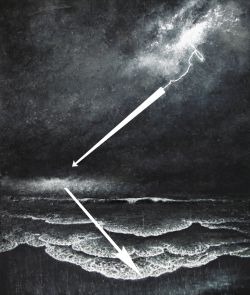
The feeling of strangeness is persistent. Light seems to emanate from the waves. It look like they arise from an unreachable distance. They give to the Ocean an almost organic consistency, where water threatens to engulf life.
The three paintings are showing significant differences in theyr respectives composition.
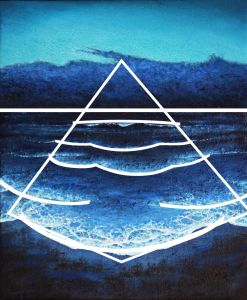
In the "Nocturnal Sea", the skyline is located on the upper third. Waves are sweeping down following curves which direct the light into a cascaded distribution contained in a pyramidal shape.
Perspective is frontal, without visible vanishing point. Only the distant waves are giving a last benchmark for the eye.
© Studio Ghibli
My neighbour Totoro - 1988


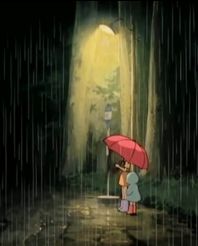
Rain and noctural night are very recurring themes for mangas producers as well as for authors of japanese woodblock prints.
The lighting style in "The Casino" is showing clearly the japanese influence.
The light is highly focused. The halo of the street lamp light is ending a bit after the bench, which allow to create a backlash that will densify the dark part of the sky and the Ocean (on the left), and the dark part of the ground and the railing (on the right).
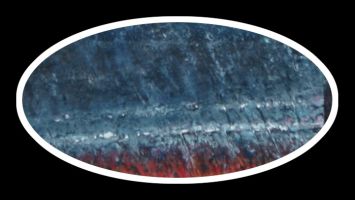
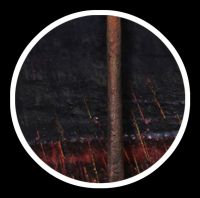
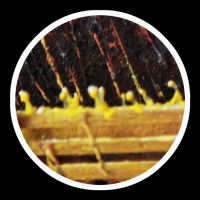
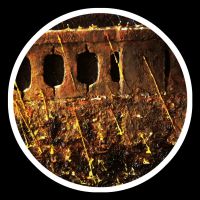
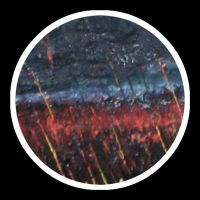
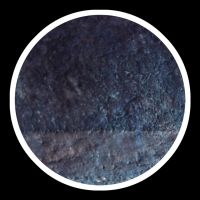
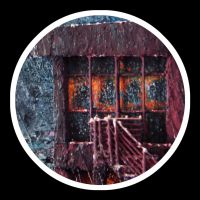
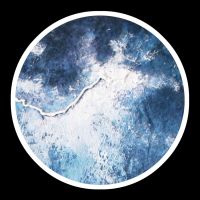
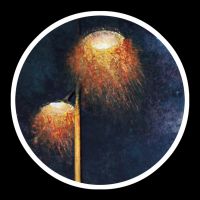
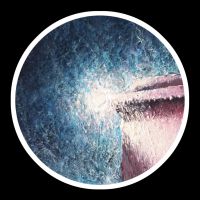
Two themes are emerging in this canvas: light and rain. Lights of the storm echoing to the light of the street lamps brightening the bench, itself echoing to the light of the building roof brightening the facade.
In this canvas, the rain can be found in all its forms: taut wires on the canvas to simulate the fall of the raindrops, long and closely spaced paint touches in order to simulate the distant rain curtain. Micro doted shades of paint to show the flooding of the rain on the windows, mix of pieces of wire and plaster in order to represent the crackling of raindrops, use of resin and fluid shades of paint in order to represent the wet ground and its reflections.
Ocean's presence in the background is more perceptible through light's reflections on the foam. Its depth is emphasized by his dark portion on the left. Even less visible, the Ocean remain an essential part of the painting: the bench is facing him, the building is facing him, the viewer is facing him.
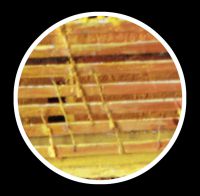
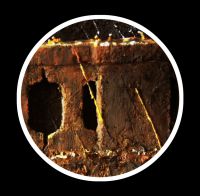
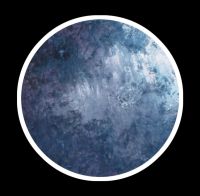
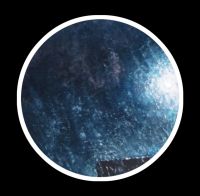
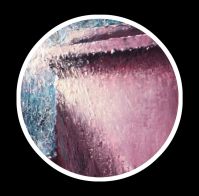
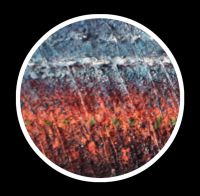
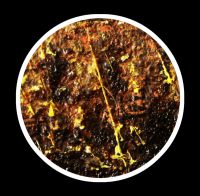
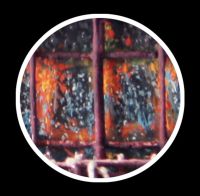
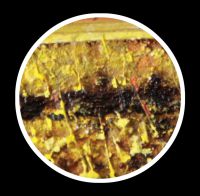
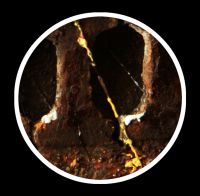
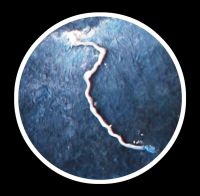
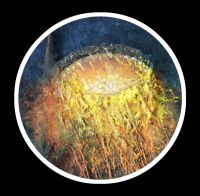
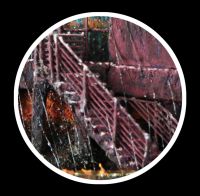
Shades of paint are very diverse: highly fluid colour patches in order to dye matters in mass without grounding theyr textures, dry brush strokes on matters reliefs, paint applied with the cutting edge of a cutter, dotted shades of paint...
Each time, paint is merging with its support. This way, every matter and theyr different textures allow an unmatched diversity of touches.
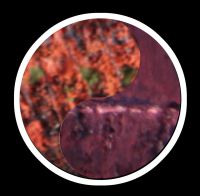

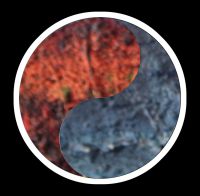
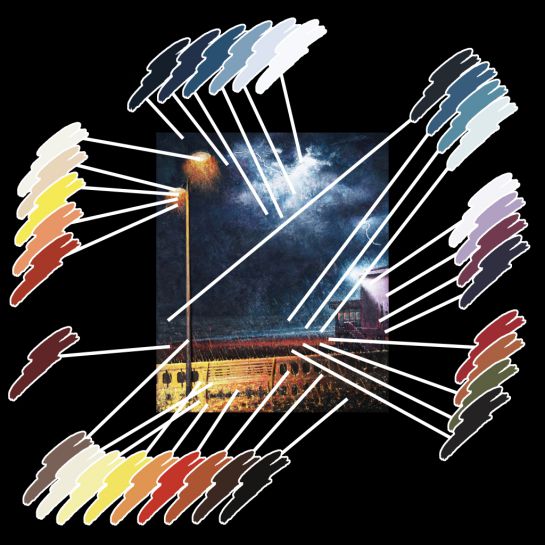
Complementary colour pairs can be found:
orange/blue between tones of lighted sandy aera and clear parts of the Ocean;
yellow/blue-violet between lights of street lamps and dark tones of the sky;
green/red between colour dots in the sandy ground and the shadowed part of the building.
In "The Casino", a various range of paints and pigments has been used, but this time there is no black.
The splitting of warm and cold tones is close to the planes separation. The ground and the details on the foreground received warm tones. The sky, the Ocean, and the building received a range of cold tones.
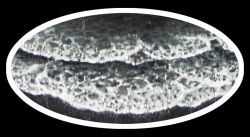
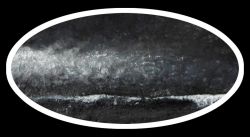
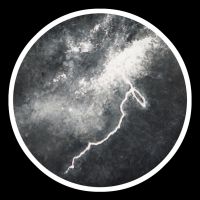
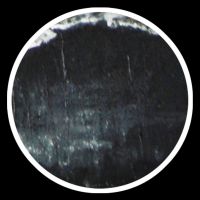
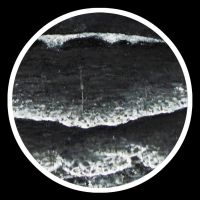
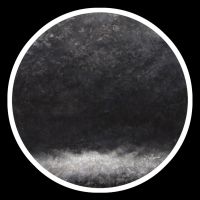
Most shades of paint are diluted in order to enter into the matters without loosing theyr textures. Only the light zones on the foam received denser touches.
The sky is entirely covered by cotton painted in mass with Humbrol paints loaded with Sennelier dry pigments.
The water mass is made of resin mixed with dry pigments, carved and shaped accorded to the waves lines.
Ground is made of sand mixed with a small amount of resin.
Thunder is made with tin wires, which allow to capture the light by separating the thunder from the sky.
Wires taut in the canvas are simulating raindrops.
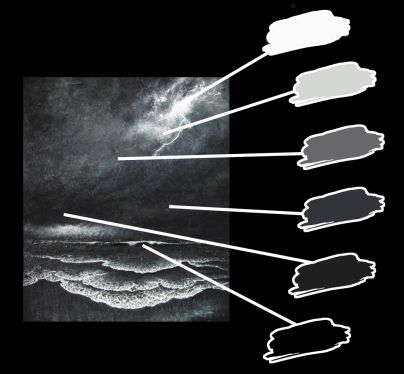
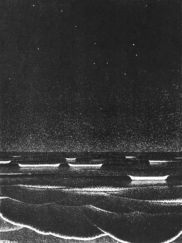
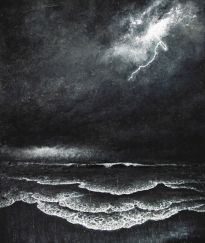
Black for Fresco is used almost exclusively for the sky since the first black and white canvases, while Ivory black is dedicated to water areas.
A mix of plaster and zinc white has been used for the light. The reliefs that it create allow to capture and bounce the outside light. This way, the external light is coming in addition to the internal light of the pigments.
The canvas is in black and white. Light is focused on the thunder and the foam. Raindrops laid here and there indicate that the rain started to fall.
The chromatic scale of "I salute you old Ocean!" is very sober. All the light intensity appear in the difference between whites and blacks, giving a feeling reminiscent of engravings and woodblock prints.
Fluid touch on a plastered surface allow very progressive color gradations, while the same fluid touch on a cotton mass will give touches as dense as the cotton itself.
On a resin surface, brush strokes will be kept visible and soft touches will highlight reliefs.
On a sand surface, reliefs stay protruding while brush strokes blend into the matter.
Dense touches of paint on plaster can enhance reliefs.
In all cases, matter's structure count as much as the gesture of the brush in the formation of a touch of paint.
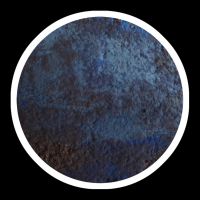
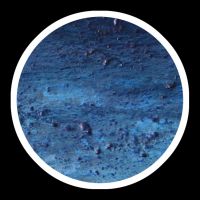
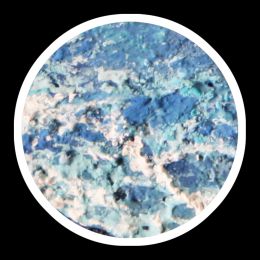
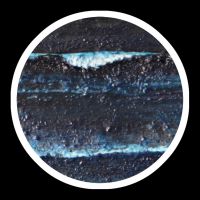
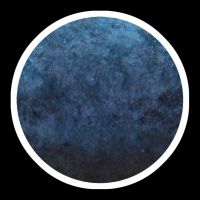
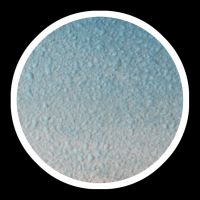
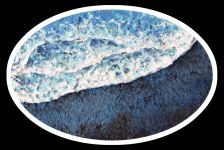
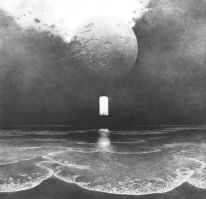
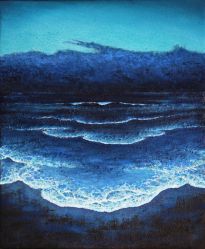
Slightly blurred shades of paint allow to keep a sense of movement.
The process of the foam take its inspiration from the style of Zdzislaw Becksinski's artworks, but the stratified reliefs arrangement of the resin is giving a feeling of solidified water.
In the "Nocturnal Sea", the main part of the chromatic scale is made of a declension of blue. Eight different blue coming from Humbrol paints have been combined with five different dry pigments: azure, primary, cerulean, ultramarine, prussian.
The sky received additional loadings of baryte green dry pigment in his clear part, ultramarine violet and black for fresco in the dark part.
The sand on the ground has been firstly coloured with wood stain before receiving paints loaded with dry pigments.
Light on the foam is made of a mix of plaster, zinc white and glue, upon which has been laid diluted coats of paint, similar to glaze layers.
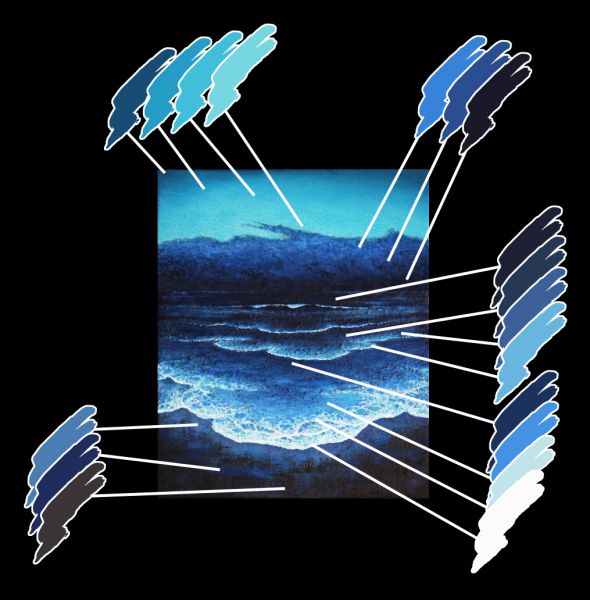
Contrary to the planes distribution, chromatic scale is very different from one canvas to another.
The same applies for "The Casino": the first drawing on the canvas is showing a railing in a lower and a more horizontal position, a higher skyline, and a barely visible building.
The ground, the sky, the building have been subject to several attempts of lighting, which are forming as many retouches.
Building has been made separatly before being sticked and included into the matters.
Light, particularly on the sandy part, has been difficult to calibrate. This light is not alone. It is connected to the dark parts as well as with the other light sources which must not be imbalanced.
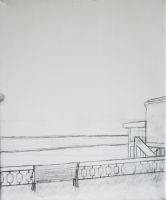
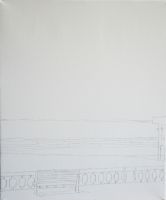
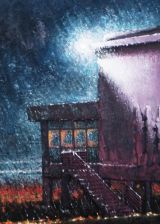
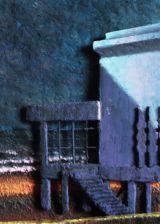











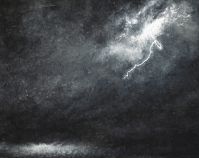
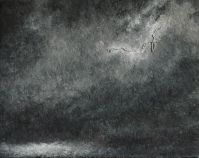
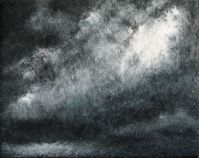
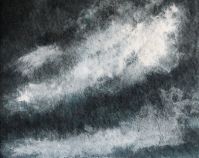
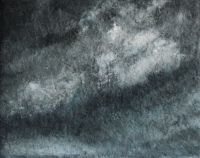
Light didn't come immediatly, several attempts have been made during the progress of the canvas.
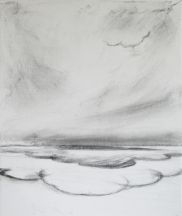
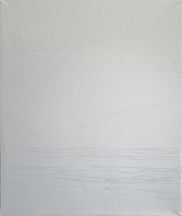
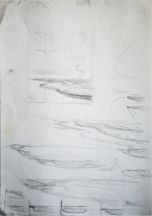
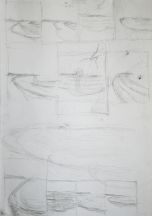
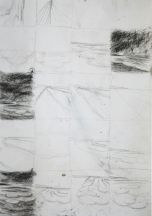
The development of "I salute you old Ocean!" began with a serie of rough drawings giving different perspectives and different mass distribution, before a pencil drawing on the canvas.
An underlayer of cement has been laid in order to prepare a gripping surface.
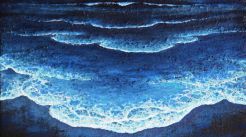
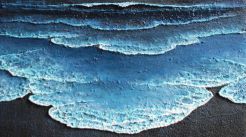
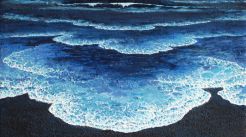
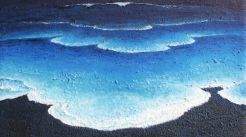
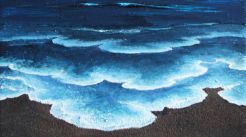

2018
1996
2018
1996
2018
1996
2018
1996
2018
1996


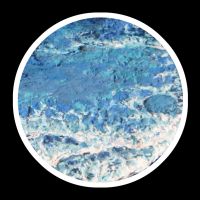
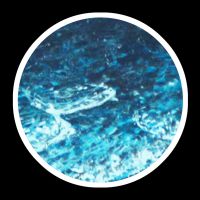




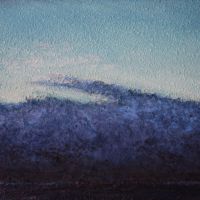

Several attempts have been made to change the waves arrangement in the 2018 version, for finaly going back to a scheme similar to the initial pattern.
Most pentimenti-traces of the "Nocturnal Sea" are coming from the changes made on the 1996 canvas:
retouching of the curved lines of the foam,
densifying of the dark parts in order to emphasize the horizon depth,
light intensification on the lower edge of the foam,
accentuated reliefs with waves carved in the resin,
spraying of a mix of plaster and glue in order to create a randomized raster pattern in the clear part of the sky,
use of cotton for the sky...
An x-ray analysis would show the 1996 canvas under the 2018 canvas.
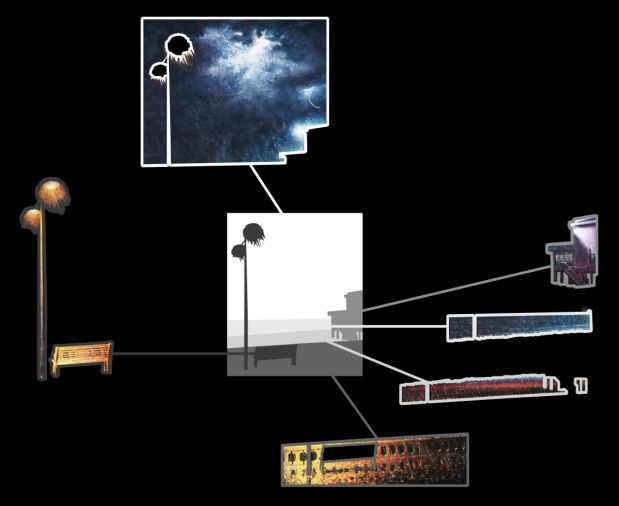
In "The Casino", we can find the sky-sea-ground distribution, which is common to the two other canvases, with the addition of a building and a foreground. The distribution of the masses of matters is accorded to matters séparation: cotton for the sky, resin for the Ocean, sand for the ground, cement for the building, cement + sand + resin for the ground in the foreground as well as the railing, wood + resin for the details on the foreground.
"I salute you old Ocean!" is similarly organised: frontal perspective and distant line of waves forming a bearing point for the eye.
However, the sky is taking the two upper third and is forming a single mass. Ocean and ground are sharing the the lower third.
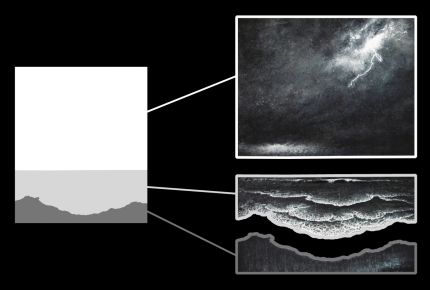
The "Nocturnal Sea" is simply organised. The sky is located on the upper third of the canvas. It is divided itself in two almost equal parts: a mass of clear sky and a highly dense mass of clouds which merges with the skyline.
The main mass is made of the Ocean and the ground in a ratio of two third Ocean for one third ground.
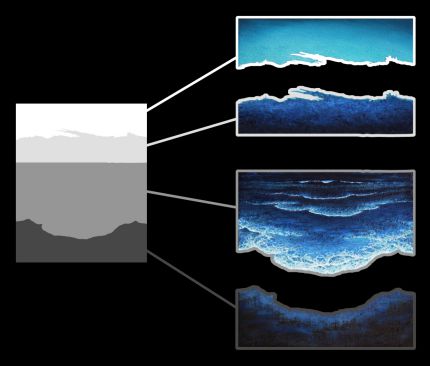
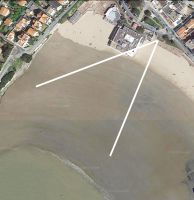



The three paintings are signed with a stamp.
The old signature on the 1996 canvas has been covered, the new signature has been affixed on the cloud layer on the right.
The signature has been affixed on the top left in "I salute you old Ocean!"...
... and on the top right in "The Casino".
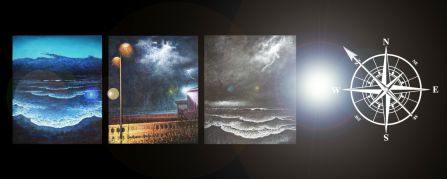
Nocturnal Sea - State of 2018
Nocturnal Sea - State of 1996
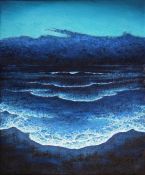
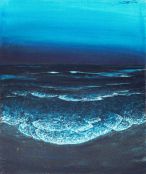
2017 - The Casino
2017 - I salute you, old Océan!
1996-2018 - Nocturnal Sea
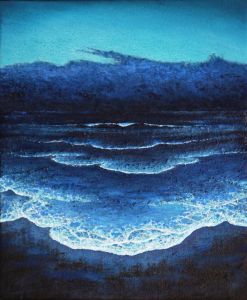
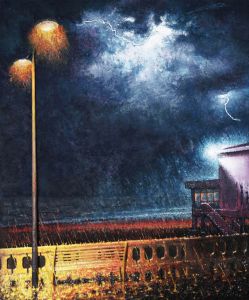
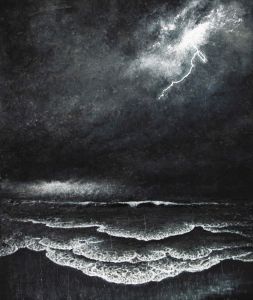
The three canvases have been worked with daylight on the right, South-East exposure. They are provided for an external lighting slightly shifted on the right or left in order to avoid reflections.
All canvases are contersigned and dated on the reverse side with the list of used components.
"The Casino" has been started in April 2017. His construction lasted about four months. This painting has been exhibited for the first time at Miami in the United States in December 2017, paired with "I salute you old Ocean!", then in Paris in early March 2020.
"I salute you old Ocean!" is in black and white. It has been started in February 2017. It required about one month and half of work. The canvas has been exhibited for the first time in Paris in June 2017, then at Miami in the United States in December 2017, and then again in Paris in early March 2020 and June 2020.
The title “I salute you old Ocean!” is a direct reference to the work of Lautreamont: Chants of Maldoror.
The first canvas to have been started is also the last canvas to have been finished.
The "Nocturnal Sea" has been done firstly in 1996. It has been exhibited in Paris in 1997 and 1998, then a last time in 2012.
This canvas has been entirely reworked starting from the end of 2017. It has been finished in early 2018 after two months of work approximatively.
They are working as interchangeable duos: two canvases with skyline on the lower third, two canvases in colour, two scenes of waves with frontal perspective, two thunderstorm scenes...
Three nocturnal scenes, three shores, only one of the three scenes is showing a located place. It is the "Casino de Royan-Pontaillac" on the Atlantic coast. By analogy, we can suppose that the two other canvases are showing sites also located on the Atlantic coast.
The three paintings, all of the same size of 42cm large for 50cm high without frame, are forming a trilogy.
“Vieil Océan, aux vagues de cristal, tu ressemble proportionnellement à ces marques azurées que l’on voit sur le dos meurtri des mousses; tu es un immense bleu fait sur le corps de la Terre; j’aime cette comparaison. Ainsi, à ton premier aspect, un souffle prolongé de tristesse, qu’on croirait être le murmure de la brise suave, passe en laissant des ineffaçables traces, sur l’âme profondément ébranlée, et tu rappelles au souvenir de tes amants, sans qu’on s’en rende toujours compte, les rudes commencements de l’homme, où il fait connaissance avec la douleur qui ne le quitte plus. Je te salue, vieil Océan!”






Fr
Eng
Paintings and matters on canvas
Luc Dartois

Pictures, texts, videos, illustration and logos contained on this website are exclusive property of Luc Dartois.
Any other use then strictly private use, any public distribution without author's permission iis prohibited.
Copyright © Luc Dartois